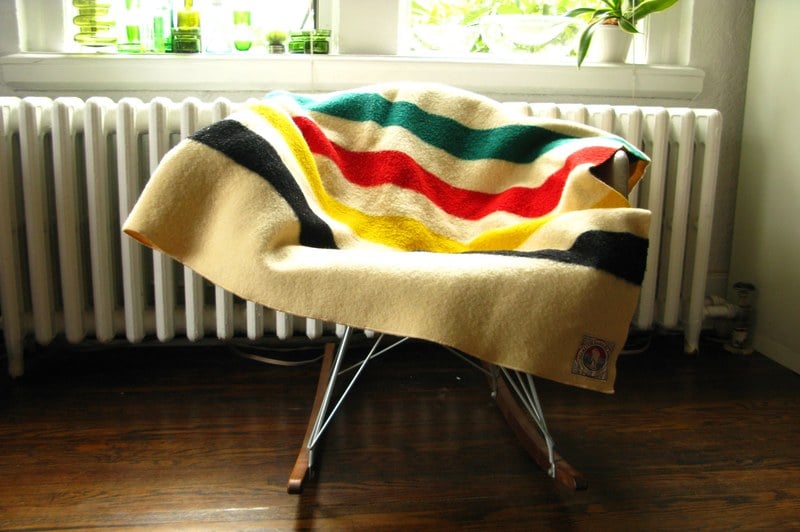It can be pretty tricky, but there are a few ways you can do it if you’re wondering how to tell the age of a Pendleton blanket. Wool blankets are a valuable house piece that many people have loved and adored over the years.

To help you distinguish the worth of your Pendleton blanket, keep reading the article below.
How To Tell The Age Of A Pendleton Blanket Precisely?
Designed through the years, Pendleton blankets have a variety of lines that includes different designs. From 1915 to 1940, the most common designs were fabric banded edges and fringes.
In 1916, they began making iconic National Parks series blankets. It started as a commission initially, but due to its unique designs and popularity, they continued producing it up until today.
Determining a Pendleton blanket’s pattern and design will help you decide whether it’s vintage or not.
-
Label
Labels often change as time passes. These modifications are not grandeur and overly different from the previous ones, but you will still see minor differences.
Earlier Pendleton labels, specifically around the 1950s to 1960s, are often located at the bottom right corner. You can also identify slight variations in the wordings used and fonts.
-
Condition
Condition is mainly the easier determiner of a Pendleton blanket’s age. These items are known for their quality material that can last after years. However, it’s still possible to see minor slashes and flaws on older versions, especially if it’s a family treasure handed down for generations.
You can also check the vibrancy of the blanket’s color. Faded ones are most likely to be old, while rich colors can signify newer versions.
What Is A Pendleton Blanket?
Pendleton blankets are from a company known today as Pendleton Woolen Mill, owned by Thomas Kay. The production started in 1909 in Oregon, U.S.A., and has been since serving the highest-quality woolen products.
Why Are Pendleton Blankets So Popular?
Pendleton established the highest-quality when it comes to blankets. It’s pretty pricey, but it is an investment piece. The designs and patterns they include in their lines are timeless and will still be considered majestic even after years of production.
Some people like to use it as wall decorations, especially on lodges and cabin hotels, rather than utilizing it to preserve its quality. The most significant thing about them is they get softer after constant usage. They are incredibly durable and robust.
Just like a classic piece of investment, they get more value than the old. Vintage hunters and designers have a great interest in these branded blankets.
What Are Pendleton Blankets Made Of?
These high-quality blankets claim only to use only the premier hair and wool to ensure the products’ softness and best condition.
-
Merino
Merino wool comes from a sheep native in New Zealand and Australia. Compared to average wool, they are a lot thinner, making them less itchy, more flexible, and softer.
It is a very popular material, and Pendleton makes sure that the consumers will not regret buying blankets made from this wool. Fine merino fibers are only 19.5 microns in diameter, while ultrafine merino measures for less than 15 microns. Merino is considerably thinner compared to most woolen fibers with 25 microns.
-
Lambswool
Lambswool, also called virgin wool, is taken from a lamb during its first sheering age of 6 to 7 months old. The material tends to be more refined and softer while still being durable. This wool is known for its solid yet smooth nature—a reason why most blankets, especially Pendleton’s, uses this as the primary material.
Lambswool is hypoallergenic and keeps dust mites away. It can help regulate the body’s temperature due to its breathability, like merino and all sorts of wool.
- Shetland
Shetland wools are from a type of sheep native in Shetland Islands, Scotland. Its silk-like texture, strength, and natural whiteness have been praised for over 200 years now. Shetland wool fibers measure 23 microns, which is definitively thicker than merino.
This material is perfect for cold climates, for this can provide sufficient warmth to the body. The only issue about this wool is it can be pretty rough for people with sensitive skins.
- Cashmere
Cashmere is a popular type of fiber known for its undeniable softness. Most high-end fashion pieces favor this material because it provides delicateness and luxuriousness effortlessly.
Cashmere comes from a particular goat found in the Gobi desert that stretches across China and Mongolia. It gives sweaters and blankets extra softness and insulation.
Items made from Cashmere tend to be a lot more expensive than other wools and fibers due to their rarity, and the way it is harvested needs a lot of work.
- Alpaca
An Alpaca’s hair is silky, durable, and strong. Most commonly, they are found in South America, specifically in the Andes Mountains of Peru. Their hair is 100% hypoallergenic, and that’s why most people allergic to wool resort to this fiber.
- Mohair
Mohair is a fiber that comes from an Angora goat. Its fibers measure 25 to 40 microns thick in diameter. It tends to be more expensive than wool due to its smooth texture and softness, just like Cashmere’s.
An Angora goat’s natural hair is coarse and fluffy, making this fiber quite fuzzy.
Are Pendleton Blankets Worth It?
Pendleton blankets are a worthy investment. It is a timeless piece that would still be valuable even after 100 years. Most families have these as an heirloom that they pass to the newest families while still looking as beautiful as if it’s new.
Pendleton blankets are a classic piece to own in one’s beloved home.
Conclusion
Pendleton blankets are undeniably one of the best products for their material quality and ability to provide comfort. We’ve discussed the types of wool used in these lasting pieces and several ways on how to tell the age of a Pendleton blanket.
